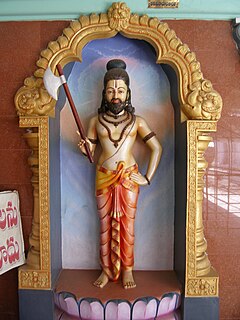| Parashurama Jayanti | |
|---|---|
 Statue of Parashurama, Tirumala Statue of Parashurama, Tirumala | |
| Also called | Parashurama Janmotsava |
| Observed by | Hindus, especially Vaishnavas |
| Significance | Vishnu's incarnation on earth and birth as Parashurama |
| Observances | Puja, fasting, scripture recitations, temple rituals, pilgrimage |
| Date | Vaisakha Shukla Paksha Tritiya (3rd day of the Hindu month Vaisakha) |
| 2024 date | 10th May |
| 2025 date | 30th April |
| 2026 date | 19th April |
| Frequency | Annual |
| Related to | Akshaya Tritiya |
Parashurama Jayanti (Sanskrit: परशुरामजयंती, romanized: Paraśurāmajayantī) is a Hindu festival observed to celebrate the birth of Parashurama, the sixth incarnation of Vishnu. It is celebrated every year on Akshaya Tritiya, falling on the tritiya tithi (third lunar day) of the Shukla Paksha (first lunar fortnight) in the Hindu month of Vaisakha.
Description
It is believed that Parashurama was born on Akshaya Tritiya during the occasion of Pradosha. According to the Skanda Purana and the Bhavishya Purana, Vishnu was born as the son of the rishi (sage) Jamadagni and Renuka. The Brahmanda Purana describes the earth goddess Bhumi assuming the form of a cow to appeal to Vishnu to save her from the atrocities committed upon her by kings, who belonged to the Kshatriya class. The deity incarnated as Parashurama as a member of the Brahmin class, raised in his father's ashram and receiving Vedic education. As a child, he was blessed by the deity Shiva with a parashu (axe). When his father was slain in an attempt to protect his cow Kamadhenu from theft by a king named Kartavirya Arjuna, Parashurama swore vengeance and vowed to end the persecution of innocents. After killing Kartavirya Arjuna and his sons, he toured the land of Bharata twenty-one times, massacring kings of every Kshatriya lineage he came across in his path in a number of wars. He halted his destruction when his Bhargava ancestors appealed to him to show mercy to the surviving monarchs; he distributed the lands of his conquests to Brahmins, and started to perform a penance at the mountain called Mahendragiri. Parashurama is regarded to be a chiranjivi (immortal), prophesied to be the mentor of the tenth avatar of Vishnu, Kalki.
Observances
Devotees of Parashurama fast on this day as a spiritual practice, denoting discipline. They share stories of the deity’s bravery and righteousness. On this occasion, bhajans, kirtans, and recitations are organised by adherents. Worship and havans are performed in different Parashurama temples. Bhandara Prasad is distributed to devotees. Shobha Yatras and Kalash Yatras are also taken out from different places in different cities, in which a large number of devotees participate.
The Tantric texts of the Parashurama Kalpasutra and the Parashurama Pratapa are recited by adherents.

The Parashurama Jayanti celebration at Parshuram Mandir in Mokama has received status of a state festival by the Bihar Government due to the popularity of the grand Kalash Yatra organised there every year.
See also
References
- Dimmitt, Cornelia; Buitenen, Johannes Adrianus Bernardus (1978-06-15). Classical Hindu Mythology: A Reader in the Sanskrit Puranas. Temple University Press. p. 63. ISBN 978-0-87722-122-7.
- Publishing, Bloomsbury (2011-09-13). Religious Celebrations: An Encyclopedia of Holidays, Festivals, Solemn Observances, and Spiritual Commemorations [2 volumes]. Bloomsbury Publishing USA. p. 18. ISBN 978-1-59884-206-7.
- Singh, Mohinder (2001). Punjab 2000: Political and Socio-economic Developments. Anamika Publishers & Distributors. ISBN 978-81-86565-90-2.
- Garg, Gaṅgā Rām (1992). Encyclopaedia of the Hindu World. Concept Publishing Company. p. 312. ISBN 978-81-7022-375-7.
- Dalal, Roshen (2014-04-18). Hinduism: An Alphabetical Guide. Penguin UK. p. 912. ISBN 978-81-8475-277-9.
- Mani, Vettam (1975). Puranic encyclopaedia : a comprehensive dictionary with special reference to the epic and Puranic literature. Robarts - University of Toronto. Delhi : Motilal Banarsidass. pp. 569–571. ISBN 978-0-8426-0822-0.
- Johnson, Wendell G. (2017-07-14). End of Days: An Encyclopedia of the Apocalypse in World Religions. Bloomsbury Publishing USA. p. 294. ISBN 978-1-4408-3941-2.
- Dwivedi, Dr Bhojraj; Dwivedi, Pt Ramesh (2020). Diamond Annual Horoscope 2019. Diamond Pocket Books Pvt Ltd. ISBN 978-93-5296-391-1.
- Varadpande, Manohar Laxman (2009). Mythology of Vishnu and His Incarnations. Gyan Publishing House. p. 87. ISBN 978-81-212-1016-4.